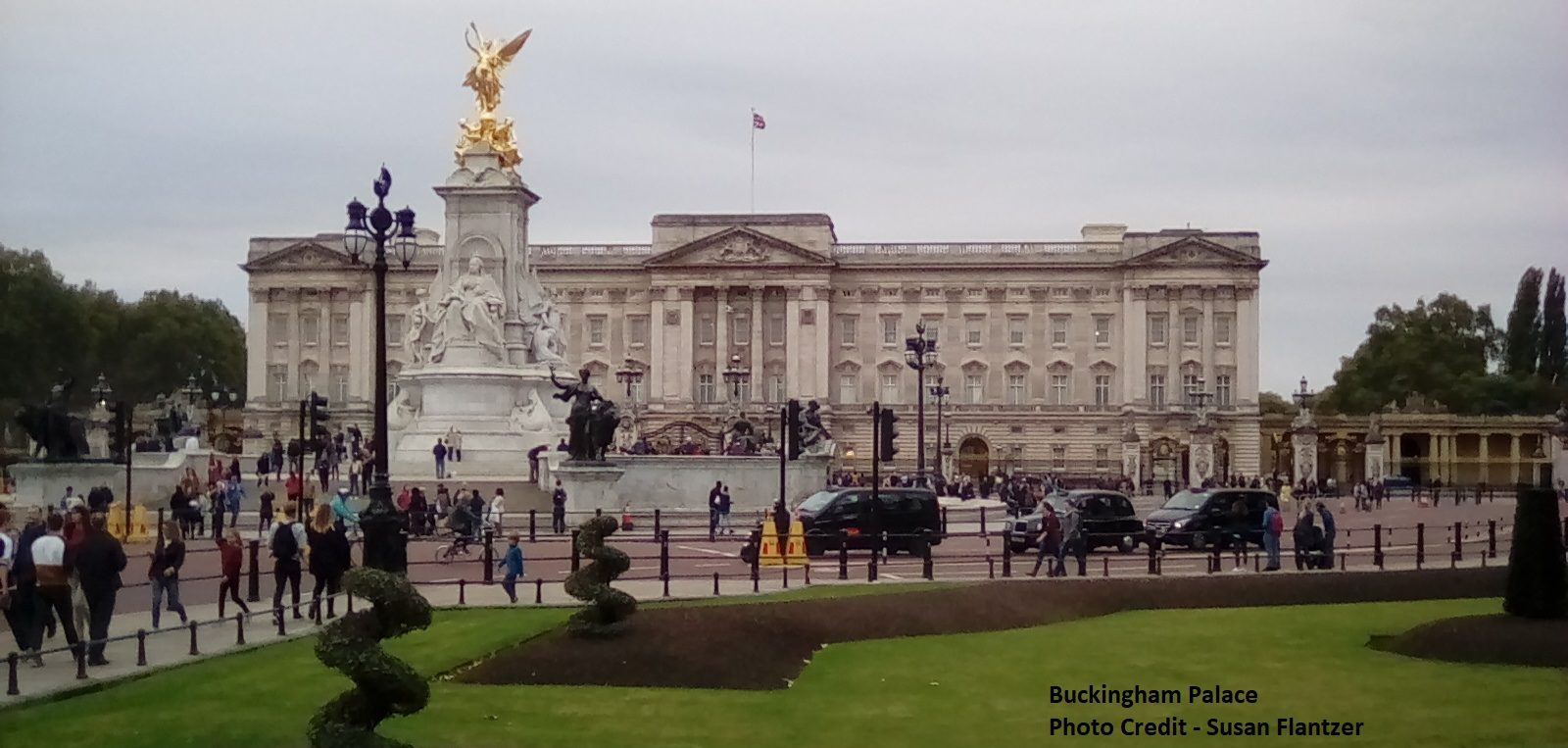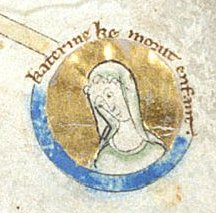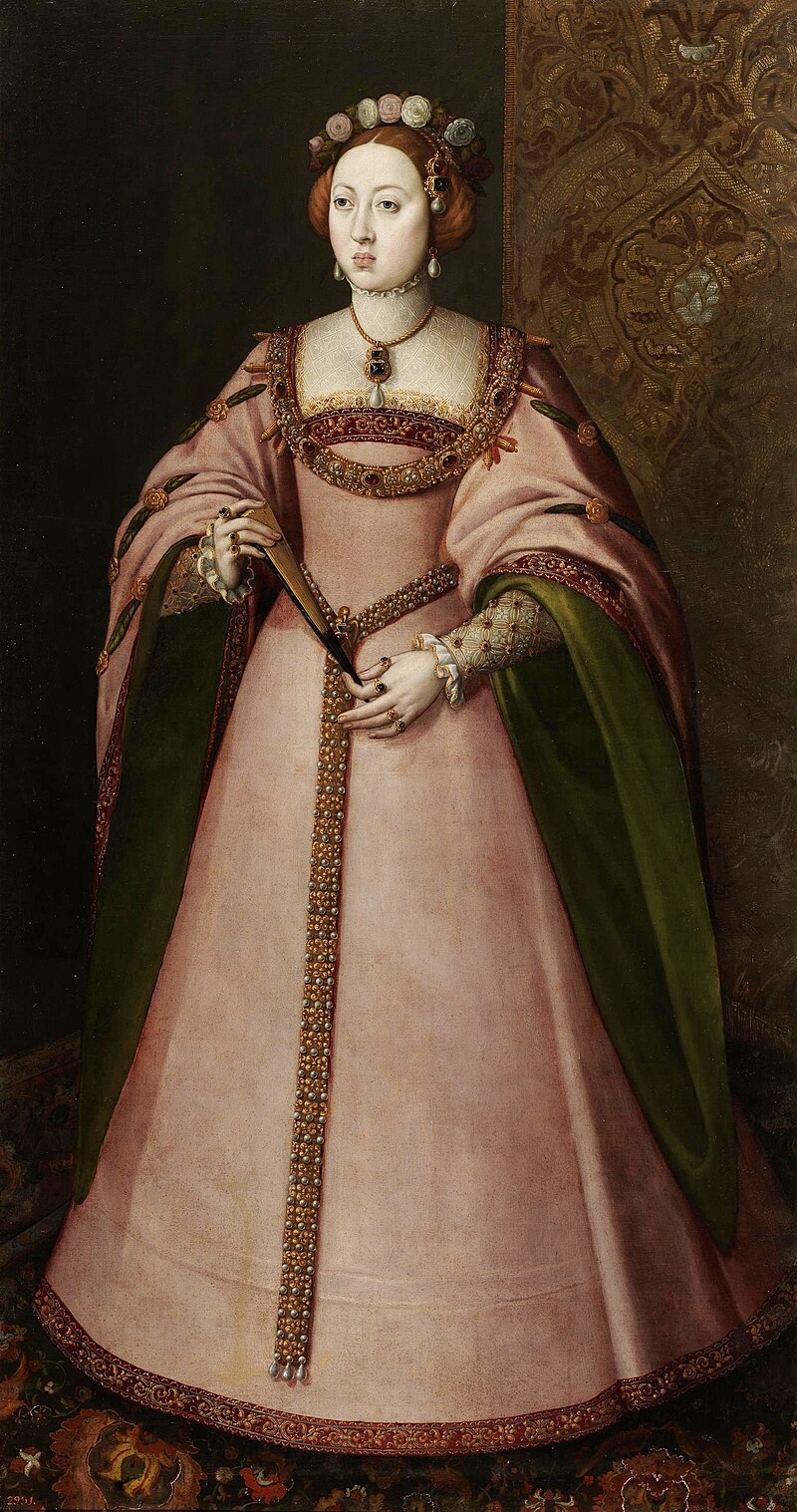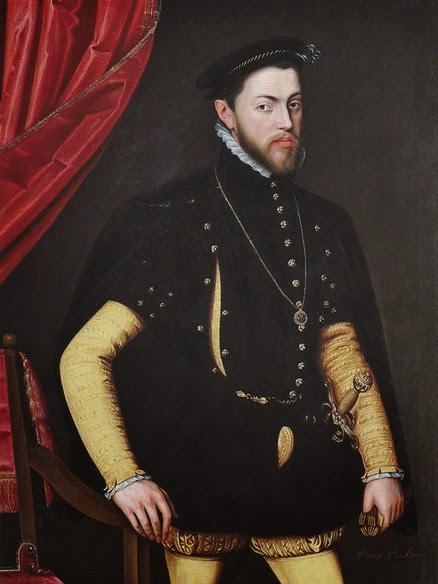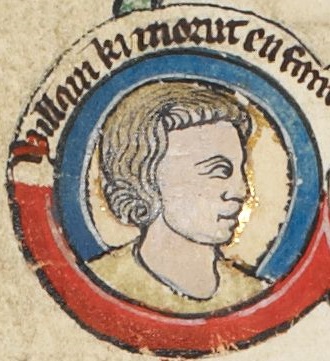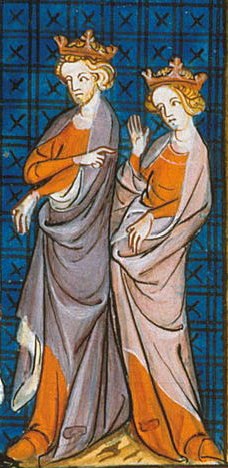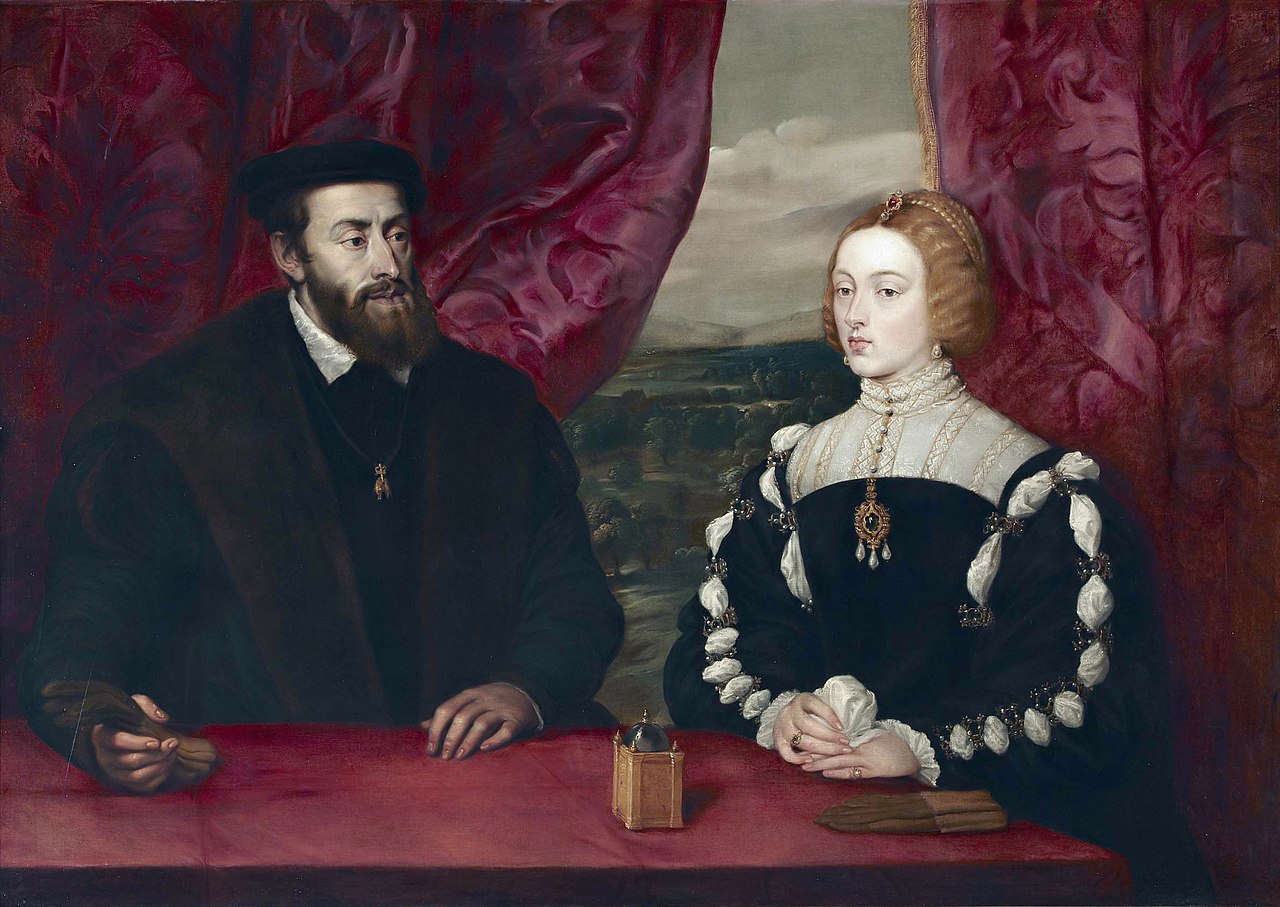by Susan Flantzer
© Unofficial Royalty 2022

Joan of Acre; Credit – Wikipedia
Joan of Acre (also called Joanna) was born in April 1272, in Acre, Kingdom of Jerusalem, now in Israel, while her parents were on the 9th Crusade or Lord Edward’s Crusade in the Holy Land. She was the fifth but the second surviving daughter and the seventh but the second surviving of the 14 – 16 children of Edward I, King of England and Eleanor of Castile, the first of his two wives. Eleanor’s paternal grandparents were Henry III, King of England and Eleanor of Provence. Her maternal grandparents were Ferdinand III, King of Castile and Toledo and King of León, and Galicia and his second wife Jeanne, Countess of Ponthieu and Aumale in her own right.
Joan’s parents had 14 – 16 children. Only five daughters and one son survived to adulthood. Joan’s eleven siblings listed below were those who were named and survived infancy for at least a couple of months. During the reign of the House of Plantagenet, their children were often identified by their place of birth. For instance, Joan was born in Acre (now in Israel) while her parents were on a crusade, and was called Joan of Acre.
- Katherine of England (born and died 1264), died in infancy
- Joan of England (born and died 1265), died in infancy
- John of England (1266 – 1271), died in childhood
- Henry of England (1268 – 1274), died in childhood
- Eleanor of England (1269 – 1298), married Henri III, Count of Bar, had one son and one daughter
- Alfonso, Earl of Chester (1273 – 1284), died in childhood, heir apparent to the English throne, but never became king
- Margaret of England (1275 – after 1333), married John II, Duke of Brabant, had one son
- Berengaria of England (1276 – 1278), died in childhood
- Mary of Woodstock (1279 – 1332), a Benedictine nun in Amesbury, Wiltshire
- Elizabeth of Rhuddlan (1282 – 1316), married (1) John I, Count of Holland, no children (2) Humphrey de Bohun, 4th Earl of Hereford, 3rd Earl of Essex, had ten children
- King Edward II of England (1284 – 1327), married Isabella of France, had four children

14th century manuscript showing Joan’s parents, King Edward I of England and Eleanor of Castile; Credit – Wikipedia
When Joan was born, her paternal grandfather, King Henry III, was still alive. In September 1272, Edward, Eleanor, and their five-month-old daughter Joan left Acre. Arriving in Sicily, Edward received the news that his father had died on November 16, 1272, and that he was King of England. Joan was left in the County of Ponthieu (now in France) to be raised by Eleanor’s mother, Jeanne, Countess of Ponthieu and Aumale in her own right. In 1279, Joan was sent to England after the death of her grandmother Jeanne, who had treated Joan so indulgently that her parents found that she was completely spoiled.
When Joan arrived in England, her father King Edward I was already planning her marriage to Hartmann of Habsburg, a son of Rudolf I, King of Germany. Through the marriage, Edward and Rudolf wanted to resume the traditional alliance of their two kingdoms against the Kingdom of France. However, the marriage of Joan and Hartmann never took place. Hartmann drowned when his ship crashed into a rock while sailing on the Rhine River in 1281.
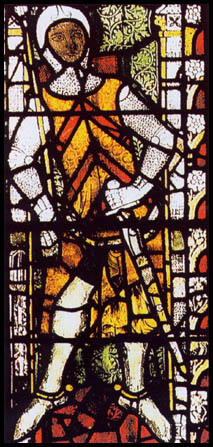
Gilbert de Clare, stained glass window at Tewkesbury Abbey; Credit – Wikipedia
King Edward I arranged another marriage for Joan with Gilbert de Clare, 6th Earl of Hertford, 7th Earl of Gloucester, probably the most powerful English baron. Gilbert was twenty-nine years older than Joan and had been previously married to Alice de Lusignan, the half-niece of King Henry III, but the marriage was annulled in 1285, although the couple had lived apart for years. Gilbert had supported King Edward I in the Second Barons’ War and had been the Regent of England between the death of King Henry III and King Edward I’s return from the Holy Land. Because Gilbert was a powerful baron, King Edward I sought to bind Gilbert and his assets to the Crown. According to the marriage contract, their joint possessions and Gilbert’s extensive lands could be inherited only by a direct descendant. If the marriage was childless, the lands would pass to any children Joan may have from another marriage. On April 30, 1290, 18-year-old Joan of Acre married 47-year-old Gilbert de Clare.
Joan and Gilbert had four children:
- Gilbert de Clare, 8th Earl of Gloucester, 7th Earl of Hertford (1291 – 1314), married Maud de Burgh, no children, died at the Battle of Bannockburn in Scotland
- Eleanor de Clare (1292 – 1337), married (1) Hugh Despenser the Younger, a favorite of her uncle King Edward II, had nine children, Hugh was executed in 1326. (2) William la Zouche, 1st Baron Zouche of Mortimer, had one son
- Margaret de Clare (1293 – 1342) married (1) Piers Gaveston, a favorite of her uncle King Edward II, had one daughter, Piers was executed in 1312 (2) Hugh de Audley, 1st Earl of Gloucester, 1st Baron Audley, had one daughter
- Elizabeth de Clare (1295 – 1360) married (1) John de Burgh, had one son (2) Theobald of Verdun, 2nd Baron Verdun, had one daughter (3) Roger d’Amory, Lord d’Amory, Baron d’Amory, had one daughter

Joan’s stepmother, Margaret of France, Queen of England, a statue at Lincoln Cathedral; Credit – Wikipedia
When Joan’s mother, Eleanor of Castile, died in 1290, only six of her children, five daughters and one son, were still living. The son, the future King Edward II, was the youngest child and only six years old. King Edward I had to be worried about the succession, and a second marriage with sons would ensure the succession. On September 10, 1299, 60-year-old King Edward I married 17-year-old Margaret of France, daughter of King Philippe III of France and his second wife Marie of Brabant.
Joan had three half-siblings from her father’s second marriage to Margaret of France:
- Thomas of Brotherton, 1st Earl of Norfolk (1300 – 1338), married (1) Alice de Hales, had three children (2) Mary de Brewes, no children
- Edmund of Woodstock, 1st Earl of Kent (1301 – 1330), married Margaret Wake, 3rd Baroness Wake of Liddell, had four children including Joan, 4th Countess of Kent who married King Edward III‘s eldest son Edward, Prince of Wales (The Black Prince) and was the mother of King Richard II of England
- Eleanor of England (1306 – 1311), died young

Memorial to Gilbert de Clare in Tewkesbury Abbey; Credit – www.findagrave.com
Joan and Gilbert lived mostly away from the royal court, which displeased Joan’s father, King Edward I. The couple’s marriage lasted only five years. Gilbert died on December 7, 1295, aged 52, at Monmouth Castle in Wales and was buried at Tewkesbury Abbey in Gloucestershire, England. After the death of Gilbert, the de Clare lands came to Joan, who took the vassal oath to her father for the lands.
Joan was only twenty-three when Gilbert died, and she fell in love with Ralph de Monthermer, a squire in the service of the de Clare family. After Joan persuaded her father to knight Ralph, they secretly married in 1297. King Edward I had arranged a third marriage for Joan to Amadeus V, Count of Savoy, and had even set a wedding date. After Joan confessed to her father that she was secretly married, King Edward I had Ralph arrested and imprisoned at Bristol Castle. Because of the intervention of Anthony Bek, Bishop of Durham, King Edward I relented and released Ralph from prison. On August 2, 1297, Ralph took the vassal oath to King Edward I as Earl of Gloucester and Earl Hertford by right of wife (jure uxoris). He managed to win the favor of his father-in-law and keep it until the end of King Edward I’s reign.
Joan and Ralph had four children:
- Mary de Monthermer (1297 – circa 1371), married Duncan Macduff, 8th Earl of Fife, had one daughter
- Joan de Monthermer (1299 – ?), became a nun at Amesbury Priory
- Thomas de Monthermer, 2nd Baron Monthermer (1301 – 1340), married Margaret de Brewes, had one daughter, Thomas died at the Battle of Sluys
- Edward de Monthermer (1304 – 1339)
Ralph took an active part in King Edward I’s Scottish Wars. He fought at the Battle of Falkirk in July 1298 when the English defeated William Wallace, and also took part in the campaigns of 1301, 1303, 1304, and 1306. For his service, King Edward I awarded Ralph with the Scottish title of Earl of Atholl, confiscated from John Strathbogie, 9th Earl of Atholl.

Joan of Acre’s burial site; Credit – www.findagrave.com
Joan died on April 23, 1307, at Clare Castle in Clare, Suffolk, England, at the age of 35. She was buried at Clare Priory in Clare, Suffolk, England, established in 1248 by Richard de Clare, 6th Earl of Gloucester, the father of Joan’s first husband. The cause of Joan’s death is unknown, but she may have died during childbirth, a common cause of death at the time.
Joan’s widower, Ralph de Monthermer, married for a second time to Isabella le Despenser, daughter of Hugh le Despenser, 1st Earl of Winchester and Isabella de Beauchamp. This was another secret marriage, made without the permission of King Edward II, Joan’s brother, but a year later, Edward II forgave his former brother-in-law. Ralph and his second wife had no children. Ralph de Monthermer survived his first wife, Joan by eighteen years, dying on April 5, 1325, at the age of fifty-five.
This article is the intellectual property of Unofficial Royalty and is NOT TO BE COPIED, EDITED, OR POSTED IN ANY FORM ON ANOTHER WEBSITE under any circumstances. It is permissible to use a link that directs to Unofficial Royalty.
Works Cited
- En.wikipedia.org. 2022. Alphonso, Earl of Chester – Wikipedia. [online] Available at: <https://en.wikipedia.org/wiki/Alphonso,_Earl_of_Chester>.
- Flantzer, Susan, 2013. Eleanor of Castile, Queen of England. [online] Unofficial Royalty. Available at: <https://www.unofficialroyalty.com/november-28-1290-death-of-eleanor-of-castile-first-wife-of-king-edward-i-of-england/>.
- Flantzer, Susan, 2016. King Edward I of England. [online] Unofficial Royalty. Available at: <https://www.unofficialroyalty.com/king-edward-i-of-england/>.
- Jones, Dan, 2012. The Plantagenets. New York: Viking.
- Ru.wikipedia.org. 2022. Монтермар, Ральф де, 1-й барон Монтермар — Википедия. [online] Available at: <https://ru.wikipedia.org/wiki/%D0%9C%D0%BE%D0%BD%D1%82%D0%B5%D1%80%D0%BC%D0%B0%D1%80,_%D0%A0%D0%B0%D0%BB%D1%8C%D1%84_%D0%B4%D0%B5,_1-%D0%B9_%D0%B1%D0%B0%D1%80%D0%BE%D0%BD_%D0%9C%D0%BE%D0%BD%D1%82%D0%B5%D1%80%D0%BC%D0%B0%D1%80>.
- Ru.wikipedia.org. 2022. Джоанна Акрская — Википедия. [online] Available at: <https://ru.wikipedia.org/wiki/%D0%94%D0%B6%D0%BE%D0%B0%D0%BD%D0%BD%D0%B0_%D0%90%D0%BA%D1%80%D1%81%D0%BA%D0%B0%D1%8F>.
- Williamson, David, 1996. Brewer’s British Royalty. London: Cassell.
- Wilson-Lee, Kelcey, 2019. Daughters of Chivalry: The Forgotten Princesses of King Edward Longshanks. New York: Pegasus.
